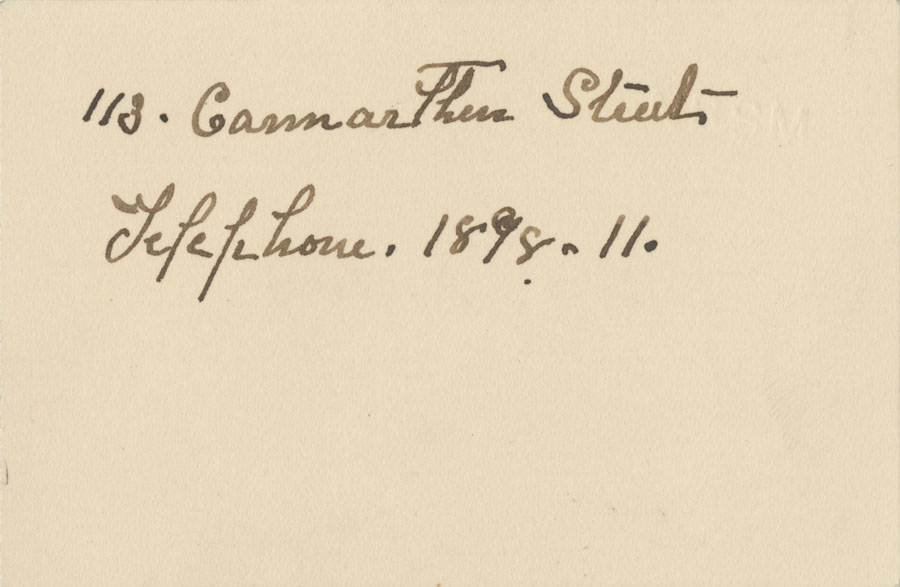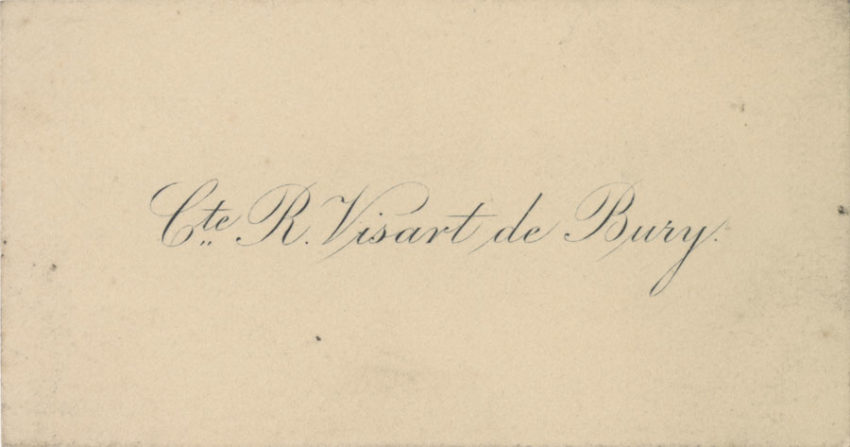There were some recent comments in our local Saint Awesome heritage group about the historic use of calling cards. One of the members mentioned we should bring them back. This got me thinking and I realized I know very little about calling cards.
I found a very useful blog to help educate me – big shout out to the creator. Calling cards might have a little identifying information about the person, i.e. a club they belong to, but these were not presented as business cards. There is a whole structure to the messaging associated with folding so I encourage you to watch the video I referenced to learn more about calling card etiquette. I plan to have calling cards made. I believe business cards have been made obsolete. Calling cards are a nice way of giving people info about you in a more personal not professional way. I like that they are fairly austere and clean in presentation.
I checked out the Archives in the NB Museum to research some of the holdings. Some items identified as calling cards seemed more like invitations, and there were many other options to look at. I have assembled an assortment below that intrigue me. All of the images are from the Printed Ephemera Collection, wF44, with the exception of the “at home” card for Mrs. G. Ernest Fairweather, which is in the same collection but F43 location – all care of the NB Museum’s archives. Do not copy the images below, I received permission from the archives – please reach out to the archives directly if you also want copies.
Below is the calling card of the wife of G. Ernest Fairweather. 29 Leinster no longer exists. I selected this card because G. Ernest Fairweather was one of the most important New Brunswick architects and his works include the beloved 80 Main St. which I discussed in another blog; the card is handwritten and austere; and, the times for visiting are clearly indicated.

Below is the calling card for Count R. Visart de Bury. I detailed the de Bury residence on Main and Douglas in another blog. I was squealy when I saw this beauty.

The calling card is for the Chief Justice of New Brunswick. I had a chuckle that no name is necessary. The title is everything the recipient needs to know.

Below is a calling card for Miss Scovil and the home address listed as Meadowlands. No address just a phrase. I googled (funny that googling is now a verb) “Meadowlands” and “Scovil” and “NB” and found reference to a fictional book written about the Scovil family home called Meadowlands in NB. I believe Meadowlands is in Lower Jemseg. Here is a fun read about a nurse named Elizabeth Robinson Scovil who moved to Meadowlands after her father faced bankruptcy and jail – she became a prominent nurse and social activist. Even if this is not the calling card of Elizabeth Scovil specifically, her contribution to nursing and to Saint John and beyond is worth learning about.

We still have a Hope Grant firm in the city so I was drawn like a moth to the flame with the calling card below. I believe this calling card references Julia nee Moody, the wife of Charles William Hope Grant – insurance agent, who lived from 1869-1945. I like that she was available the 1st and 3rd Wednesday at 200 Princess St which still stands.

I chose to share the calling card below because of the University notation. Calling card are simple and practical. The choice of indicating the University by John Davidson says a lot about what he valued and perhaps where to connect with him.

I selected the business card below from Mrs. A.G. Blair because of the strong solid border and handwriting. 66 Orange St still exists.

The McAvity name is an important one in the history of Saint John – thinking about fire hydrants and munitions in WWI. Below is the calling card from Mrs. John A. McAvity.

Mrs. Joseph Allison and Miss Allison shared the same calling card inviting people to visit them at Rathbone House. The Rathbone house, I believe, is located at 260 Princess St. and later became the Evangeline Maternity Hospital. Mrs. Joseph Allison was the wife of the Joseph Allison of Manchester Robertson Allison department store fame in Saint John, NB. Rathbone, of interest, was a family name in the Allison family. The Archives in their database has photographs of Mr. and Mrs. Joseph Allison. I believe Joseph and Helen Allison had two sons – William and Walter – and no daughters so I am not sure which Miss Allison is referred to here.

I had to include the calling card for Mrs. Purdy below. The Purdy family is a prominent one in Saint John and I have researched some of them in previous blogs. 182 Princess St is still in existence.

I included Mrs. A.C. Jardine below because of the recent kafuffle over destroying the Jardine residence on Westmorland. I am not saying that this is the calling card for the wife of the original owner of 110 Westmorland, but the Jardine name comes up so often (i.e. Jardine’s Alley) in Saint John it is too exciting not to add to this blog.

I learned a lot from E.M. Wesley – Bible Woman. Yup, Bible Woman is a real thing – check out the link. Emma M. M. Wesley lived from 1839-1927 and died at her home at 113 Carmarthen – the building still exists.


I could not resist a fun little 1925 article about Emma Wesley, just two years before she died.

I also found some colourful calling cards that seemed a little less substantial than others and appear to have had the names stamped on. Below are two examples.
I selected this card because of the strawberries. My husband’s last name means strawberry.

And this one was chosen because it is pretty and my own name is a diminutive of Caroline.

After publishing this blog, I had the great opportunity to acquire a set of calling cards.


Inside is one of my favs. I like how the name is below the picture and the picture is of a boat which to me is a nod to the shop history in Saint John. The top left corner is turned over indicating someone is saying congratulations or felicitations.


Happy to learn more about calling cards and specifically their place in Saint Awesome!

Very, Very Interesting indeed. I love to learn about things in the past. Thanks for posting and sharing.
Thanks for taking the time to read and comment.